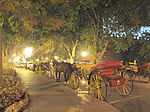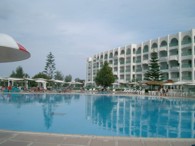An attractive travel destination - Palma de Mallorca, the largest city and port on the island of Mallorca and the capital of the autonomous community of the Balearic Islands, is the symbol of the real Spanish tradition. Phoenicians, Greeks, Romans, Byzantines and Arabs fought through centuries for this beautiful island in the Mediterranean Sea. Just like Spain itself, both Mallorca and Palma were under the Moors rule from the 9th to the 13th century. Thus, this heritage is still obvious, both in building and culture, tradition, habits, cuisine and temperament. Trace of the golden era of Palma are obvious. It was on the top of its power and reputation in the 15th century, when it was the main port in the traffic between Europe and Africa. At present, Mallorca is one of the most populat travel destinations in Europe, to which the first charter flight with tourists landed already in 1950. Although 40% of the island area is uninhabited and it consists of three National Parks, Albufera, Dragonera and Mondraga, it has got also a long coast including the most popular worldwide summer resorts El Arenal, Kala Major, Palma Nova, Magaluf (the nigh life center of Palma, with the most attractive discotheques and beer tavernas), Pagera, Santa Ponsa, Kala D'or, Alkudija, Kala Ratjada and others.
Wherever you come into Palma from, located in the wonderful bay Bahia de Palma, the first thing one sees is the monumental Gothic cathedral, built from 1230 to 1600, partially restored in the modern style by Antonio Gaudi. It dominates the city impressively any time of a day. Whether you start your walk along the sea by the attractive avenue Paseo Maritimo, or just from the center, from Plaza Espagna, as the central square is called in all cities in Spain, or the very center of the old part of the city, everything is astonishing. Close to it is also the national museum Almudaina, with a collection of paintings, furniture and tapestries. The Old Town, through which one may walk or drive on an decorated carriage with hitched horses, is full of buildings in the Italian Rennesaince style with Arabic ornaments, built since 15th century by aristocrats and rich sailors. In the port, huge ships for the Mediterranean cruising rest and the view provided by private modern and luxurious yachts of the worldwide billionaires is really amazing. As gratitude sign, the inhabitants of Mallorca gave their main city avenues the names of their rulers. There is, first of all, Haime I, who liberated Mallorca from the Moors and pronounced himself the King and then, there are his heirs Haime II and Haime III. The ruling period of these Kings is famous for the new culture boom, when Catalan language (Mallorca dialect) gets its alphabet and the Kingdom of Mallorca becomes one of the most important centers of the Gothic arts. Another important personality was also Juan March, famous as a great businessman and financer who influenced the contemporary financial boom of the island and left many legates behind him. In one of them is situated the Museum of Spanish Modern Arts, where paintings of Huan Miro, Picasso and Dali.
| WHAT TO SEE |
|
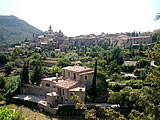
|
A typical Mallorca style village in the bay of Palma, dominated by a Carthusian Monastery founded in 1339. Next to it, a palace of the first Kings of Mallorca was built, as well. A winter staying of Frederic Chopin and Georges Sand in the Monastery, in 1838/1839, contributed to the worldwide popularity of this destination |
|
|
|
|
|
The main attraction of this picturesque town with a beautiful cathedral is an old, wooden tramway, passing the pedestrian square with cafes and performs a tourist tour of the town and coast sightseeing |
|
| DRAK CAVE |
From the previous fishermen's village Porto Cristo, at present an exclusive tourist place, little ships take you to the Drak Cave, one of the largest ones in Europe, with a lake in its middle |
|
|
| DRAGONERA ISLAND |
|
A nature park across the place Saint Elm, where the photo safari fans make photos of the iguana spawning place |
|
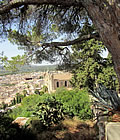 |
ARTA |
60 km far from Palma, on the slopes of Sierra Artana mountain, there is this picturesque place with a wonderful view.
The place is dominated by a church, museum and art colonies with great hand made items
|
|
| ALBUFERA and MONDRAGA |
National parks with many rare plant and animal species |
|
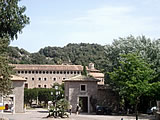 |
POLLENSA |
This attractive town on the north of Mallorca used to be a destination of pilgrims and at present of tourists instead |
|
|
|
|
|
|
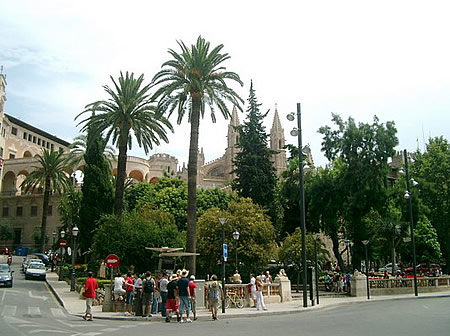
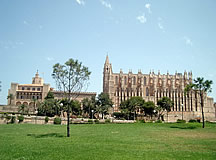 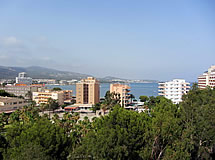
From the starting point at Plaza Espagna, the way takes through the picturesque section of the Old Town, a maze of curved streets and mini squares, shops and cafes. Everything is full of life here, from talented musicians and painters, to the artists who, imitating the sculptures, stand motionless for hours at the hot sun, while continuous lines of tourists attempt to take their photo next to them. The most important and last square on this line is Plaza Mayor, which is the day and night center of all events in the Old Town. All these minor streets with stairs come down to the lower sections of the city and like a branchy river mouth enter from all sides the newer section of Palma with wide avenues, magnificent buildings from the 18th century and huge luxury shops and restaurants.
In spite of the invasion of international tourists, construction of many aqua parks and shopping malls, Palma kept its local colors and it is a place for the real royal rest. Hence, the is no wander that at the city exit toward the resorts with the nets of modern hotels of all classes and offer types. There is also the summer residence of the King of Spain, Huan Carlos - Villa Marivent. In the royal style, just like that.
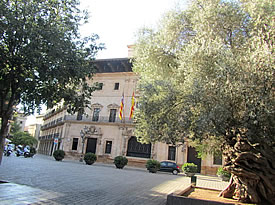 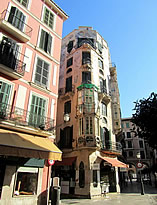
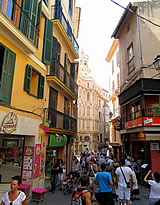 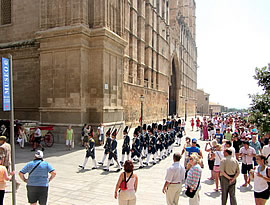
| WHAT TO TASTE |
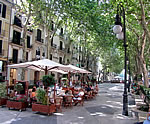
|
Various types of fish, first of all lobster, prepared in many ways (among others in the orange sauce), oysters, crabs, paella and excellent Spanish croquettes
Rolled meat Sobrasada is the specialty of Mallorca |
|
The best known Mallorca sweet desserts are Crespells and Ensaimada, a pie with apples and cream |
|
|
|
|
